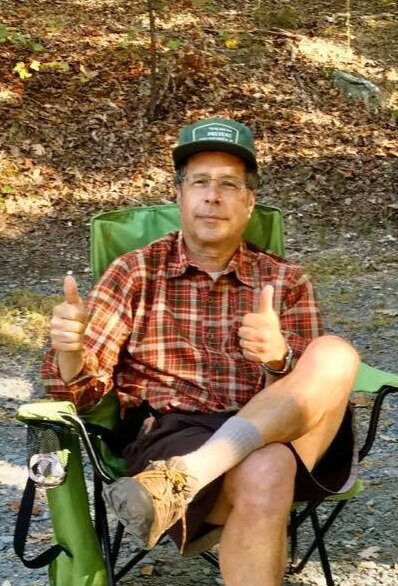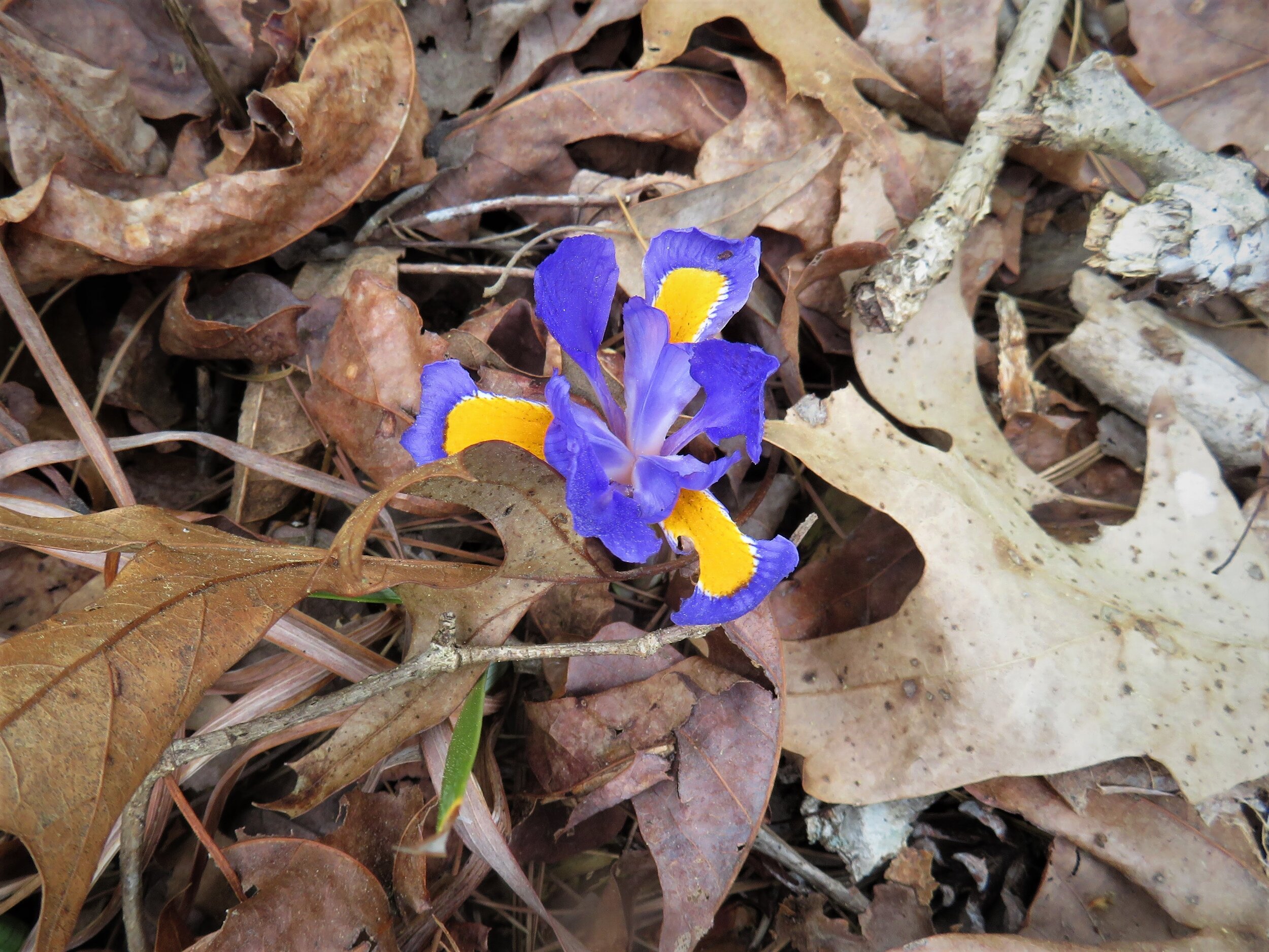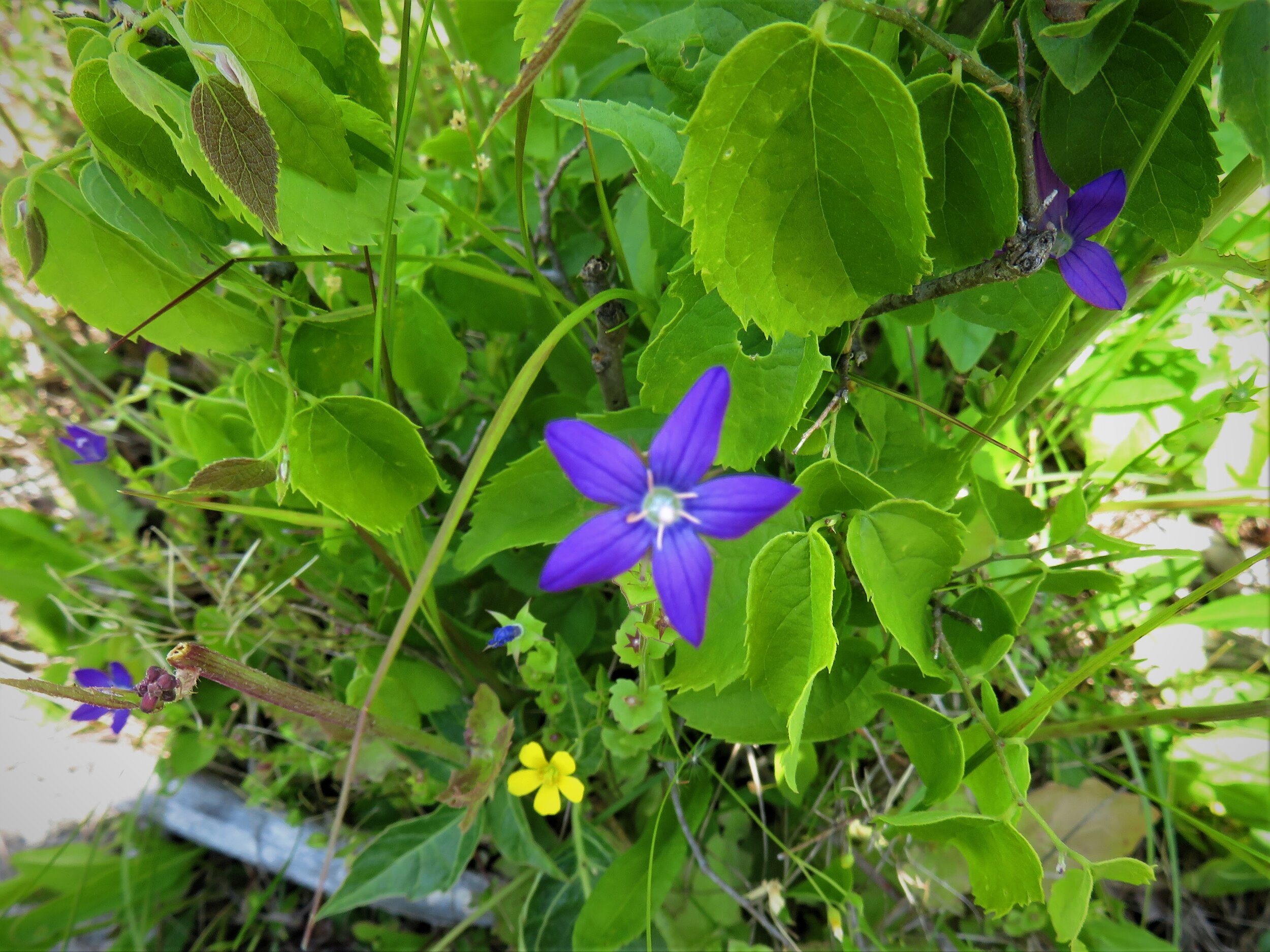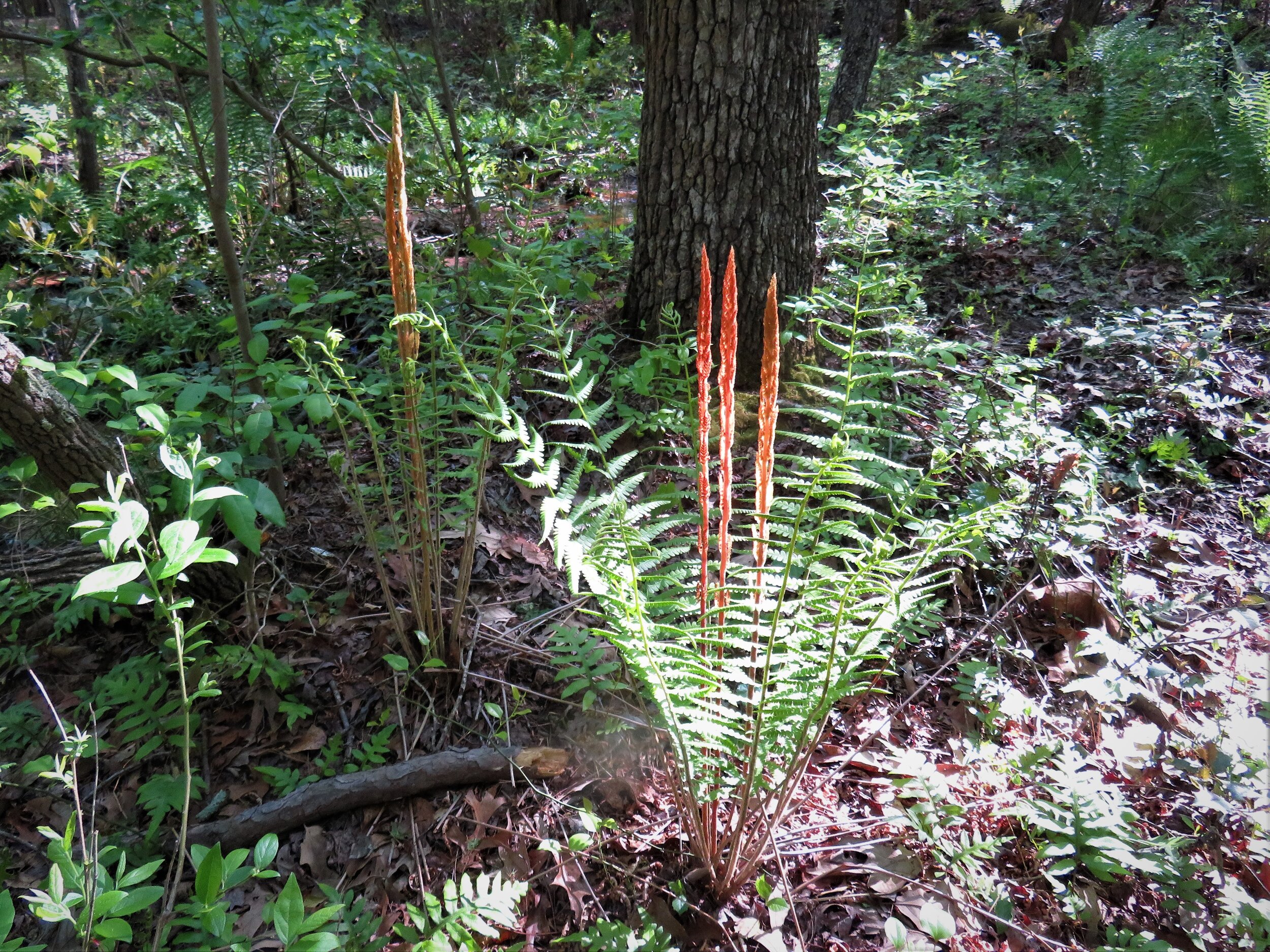Welcome to the inaugural issue of the Uwharrie Trailblazers Newsletter - summer 2020!
The Uwharrie Trailblazers hope this newsletter, to be published quarterly, will serve to keep all Uwharrie Trailblazers hiking club members and the general public informed about our projects, activities, and events.
A Uwharrie Trail camp scene. Photo by Joe White.
Message from the chair
David Craft
Founder of the Uwharrie Trailblazers Hiking Club
Summer 2020
Welcome to our first newsletter from the Uwharrie Trailblazers. We have communicated via email and Facebook since our inception over 5 years ago. We will send out a quarterly newsletter to members as a more official way of communicating.
Created unofficially in 2015, we began working on the trail over Little Long Mountain in 2012 in support of the Three Rivers Land Trust.
We have worked closely with the TRLT and Uwharrie National Forest on various projects including the October Thru Hike.
We hope to continue with workdays soon and thru hike in the fall.
We have started a new Trail Adoption Program, more info here and in this newsletter! Sections can have more than one adopter. Let us know if you are interested.
Our number one club goal is completing the historic length of the Uwharrie Trail. More here. In the meantime we hope to add more miles of trail in other areas while we maintain current foot trails.
I want to thank our talented committee here. We could not do what we do without all these hands.
If you are interested in being more involved, shoot me a note Chsyhkr@gmail.com.
As my long time trail friend and neighbor Ruth Ann Grissom says,
Onward!
David Craft
Club Chairman and Bus Driver
PS - I feel more like Reuben Kincaid, if you know what I mean.
Trail Update
Uwharrie Trailblazers Trail Adoption Program
Jim Plant
The Uwharrie Trailblazers have partnered with the Uwharrie National Forest to adopt all hiking trails in the National Forest. The club has an agreement with the Forest Service to adopt all hiking trails. Our program divides the work up among volunteers.
Trail crew working in the Birkheads, February 2020. Photo courtesy of Jim Plant.
Our Trail Adoption program is designed to maintain 59 miles of hiking trails in the Uwharrie National Forest. We cover the entire Uwharrie Trail, Dutchmans Creek Trail and all the hiking trails in the Birkhead Wilderness. Jim Plant is administering the program and the Trail crew is led by Trail Bosses Joe White, David Gardener and Gifford Del Grande.
The basics are:
Each of the 18 sections are adopted on a one year, calendar year basis. There will be a process to renew at the end of the year.
We ask that each adoptee walk their trail at least twice a year doing light maintenance, loping, cleaning water bars, cleaning campsites along trail, removing debris, cutting small deadfalls with a handsaw and reporting your work by submitting a Work Report form to Dave Gardener, our volunteer coordinator.
Trail problems which require crosscut or chainsaw work can be reported on the Work Report so the Trail Bosses can address it on a workday with those certified to do that work. Crosscut and chainsaw work done in the National Forest must be done by a certified sawyer.
Report any damage to or missing trail signs and blazes.
We encourage you to do your adoption work with a partner or a team.
The most current information about the Trail Adoption Program can always be found here. If you are interested in helping, we’d love to hear from you. Email us at uwharrietrailblazers@gmail.com
Photo Essay
Springtime in the Uwharries
Jim Plant
Some people say Spring begins when the daffodils bloom. It's different every year. This year they appeared in early February.
Of course, daffodils are not native to the Uwharries but they have been here for hundreds of years. Throughout the Uwharries, they mark the spots where folks once lived. The houses and outbuildings are gone. The chimneys are a pile of rocks. However, the daffodils remain intact. Above is a bunch that have taken over this former homesite. I call it "Daffodil Flats". Just like Linville Gorge, now the Uwharries have their own.
Now, let's look at some of the native wildflowers found in the Uwharries.
Hepatica
The early Spring blooms include Hepatica. Usually a loner or in small colonies. You have to get up close to enjoy this beauty.
Trout Lily
Next up are the Trout Lilies. A weird looking flower, facing down. Sometimes called a Dog Tooth Violet. Hmmm, how did get that name? If you pull one up, it is attached to a long tube with a small bulb attached. It looks like a tiny tooth. The leaves are unique and resemble trout spotting. So, I'm sticking with Trout Lily.
Bloodroot
Now we are talking. This showy beauty is a Bloodroot. The roots are red just like its name says. This one has some Trout Lilies growing nearby - see they leaves?
Dogwood
Everyone knows this one. Dogwood blooms are impossible to miss. The blooms appear before the tree leafs out, so it is right there for everyone to see. When the blooms are gone, the tree is still easy to spot because of its bark. Ha ha.
Sessile Bellwort
Sessile Bellwort is an easy to miss, subtle flower, just above the leaf litter. Its flower faces down and resembles a bell. "Wort" is from an Old English word meaning a plant that has medicinal properties. Bellworts were used to make a poultice for wounds and inflammations.
Little Brown Jugs
Why is this plant called "Little Brown Jugs" ? Look at the flower. My knife blade points it out. The leaf, when squished up, smells like ginger.
Pinxter Azalea
One of the genuine treats of the Uwharries, is seeing a Pinxter Azalea in bloom. The blooms appear before the leaves. Some folks call it Naked Bush for that reason. With such a showy bloom and up 6 or more feet off the ground, you'd think this was an easy bloom to spot but I often have trouble spotting it even when I know where to look.
Bird’s Foot Violet
Do the leaves of this plant look like a bird's foot? Sometimes they do, but I don't see it on this one. Bird's Foot Violet they call it.
Pussy Toes
This one gets overlooked. The bloom doesn't look much like a flower. It also spreads like a ground cover. Pussy Toes are in the Spring lineup for the Uwharries whether they get noticed and appreciated or not.
Dog Vomit Fungus
Whoa! It's a fungus. This one looks like a yellow dog. Very appropriate for Dog Vomit Fungus.
Dwarf Iris
One of my favorites, Dwarf Iris. The flowers are small compared to domesticated Iris. The flowers appear to be growing out of leaf litter. I see this often throughout the Uwharries. Many do not bloom.
Fly Poison
One of the flower types I like to call flower on a spike. This one is Fly Poison. You can't talk about Fly Poison without mentioning why it's called that. Everything is poisonous about this plant, the bulb, the leaves, the flowers.
Cedar Apple Rust Fungus
Oh no! My Eastern Red Cedar tree has Covid-19. Spring is the time of year for the slimy orange fungus on Eastern Red Cedars, to make its annual appearance. Cedar Apple Rust Fungus requires both trees, cedar and apple to be present. The fungus begins to appear in early spring on cedars. The spores then are blown to nearby apples. Then in the fall, the spore migration heads back to the cedars. Although, this fungus is not harmful to cedars, it can ruin a apple crop. The following is from Mass Audubon Blog - Your Great Outdoors:
In 1914, apple growers wrote the Cedar Rust Act of Virginia allowing them to destroy cedar trees on neighboring property in an effort to control the fungus. While most people enjoy eating apples, a lot of people also like eastern red cedar trees, especially if they’re on your own property. You can imagine how people reacted when they woke up to see their neighbors cutting down all their cedar trees.
This all came to a head in a classic 1928 court case where a judge determined that apple trees were more valuable than cedars, and therefore more worthy of protecting. Cedar tree owners would not be compensated for their losses, but would be allowed to keep the wood from the cut trees. Remember to thank those folks who lost all their cedars next time you bite into a delicious apple!
Wool-Sower Gall
Now my White Oak has Covid-19. A Wool-Sower Gall made by Cynipid Wasps. Got that?
Twayblade Orchid
Twayblade Orchid is one of the strangest blooms in the Uwharries. They are small and close to the ground and very hard to spot.
Galax
Everyone knows Galax. It's another flower on a spike. Galax leaves were and still are used in floral arrangements since they appear fresh for long periods of time. Poaching used to be a big problem. So much so, that I once saw the word used as a verb. The sign said "No Galaxing."
Prickly Pear
This beauty is a cactus bloom. Some of the open mountains in the Uwharries, host Pickly Pear cactus. Found in abundance in Mexico, the Mexican coat of Arms depicts an eagle eating a Diamondback Rattlesnake while perched on some Prickly Pear growing on a rock submerged in a lake. When the Aztecs saw this scene occurring, they built their capital Tenochtitlan. According to legend of course.
Prickly Pear and Yarrow
More Prickly Pear, paired up with some Yarrow on Little Long Mountain.
Blue Eyed Grass
Blue Eyed Grass actually has a grasslike leaf. You can't see it here. Pretty little flower for late Spring.
Fire Pink
Fire Pink is seen throughout the Uwharries in May and June. These are from Little Long Mountain.
Cinnamon Fern
See why this fern got its name? Cinnamon Fern.
Cinnamon Fern
Another Cinnamon Fern.
Mountain Laurel
You have to bring up Mountain Laurel when you talk about Uwharrie blooms. These are just about ready to open. When they start as buds, the bush looks pink with blooms. However, once open, the flowers transform the bush from pink to white and pink and finally to all white.
See?
Cross Vine
Cross Vine grows up a tree and spreads its blooms out in the canopy. You have to look up sometimes to see the cutest blooms.
White Fringetree
White Fringetree is a very small tree. The fringelike bloom doesn't last long.
Trillium
Yes, Trillium grows in the Uwharries. This Nodding Trillium was spotted at Jumpin Off Rock Trailhead.
Foamflower
Foamflower, another flower on a spike. They look like fireworks going off.
I know there are plenty more Uwharrie blooms. These are photos I have taken this Spring in the Uwharries. Go out and look for some. You'll be amazed at what you see.
spotlight
Stanley Siceloff
Kim Andersen
This first UTB Newsletter “Spotlight” feature shines a light on Stanley Siceloff, a stalwart supporter of the Uwharries and longtime dedicated club member. Stanley is a graduate of Lees-McRae College, worked for many years with Burlington Industries and later with Unifi, and has lived most of his life in and around Burlington. He is well known on the trails of the Uwharries as a skilled woodsman, a great friend, and an incredible snake charmer.
Stanley Siceloff at the end of the 2018 Uwharrie Thru-Hike. Photo by Joe White.
“He is a hiking machine,” says fellow Uwharrie hiker Marcus West. “His pack never weighs over twenty pounds and he likes Vietnamese food. He’s fun, loves the outdoors, more than anything he’s a good friend. He will always find a reptile and is very knowledgeable in most things crawling on the ground.” According to Stanley, this is how it all began:
I saw a snake in a creek in my old neighborhood in East Burlington and grabbed it. I was five. I started with Black Widows when I was about 3. They are still beautiful even though I get spooked by some spiders.
In getting to know Stanley and interviewing him for this piece, it became clear that his story and his relationship with the Uwharries are best told in his own words:
I started coming to the Uwharries about 1980. It seemed stuck in the 50's with its remoteness. The miles of trails was what interested me. One morning in May walking from Robbins Branch trailhead I stopped in the misty morning and asked myself a question. "What are you looking for in here?” [And the answer came] “I'm not looking for anything, I come here because I've found it.”
Aside from the fact the Uwharries are the oldest mountain range in the United States, [people] should know it's a great place to get away from it all. My friends and I will tell you it's not quite as empty as it used to be. It may be less crowded after the lockdown but the quiet and solitude are becoming harder to find.
I found out about the Thru-Hike on Facebook and met David Craft who told me about the Trailblazers. August 14th will be six years a member. I needed the feeling of accomplishment the work brings me. Being a part of something bigger doing something I love.
There is feeling about this place for me that it somehow will look after me. I have always felt that way. The views are spectacular. It seems stuck in a time years ago. The people as well have a pioneering spirit and a feeling of being one family.
I came for the snakes and stayed for the feeling of doing something that was lasting.
Described by Uwharrie Trailblazers veteran Dave Gardener as “a humble servant who is always dependable and there to help,” Stanley is the epitome of self-deprecating strength, intelligence, and good humor on the trail and off. Thank you, Stanley Siceloff!!!
Editorial policy
The contents of this newsletter are authored collaboratively by the Uwharrie Trailblazers steering committee unless otherwise attributed and are intended to illuminate, educate, and inspire all who enjoy the trails of the Uwharries. The newsletter is edited by Uwharrie Trailblazers club secretary Kim Andersen. We welcome suggestions and questions from all readers.
Please send feedback and questions via email to uwharrietrailblazers@gmail.com and visit us on Facebook!



































